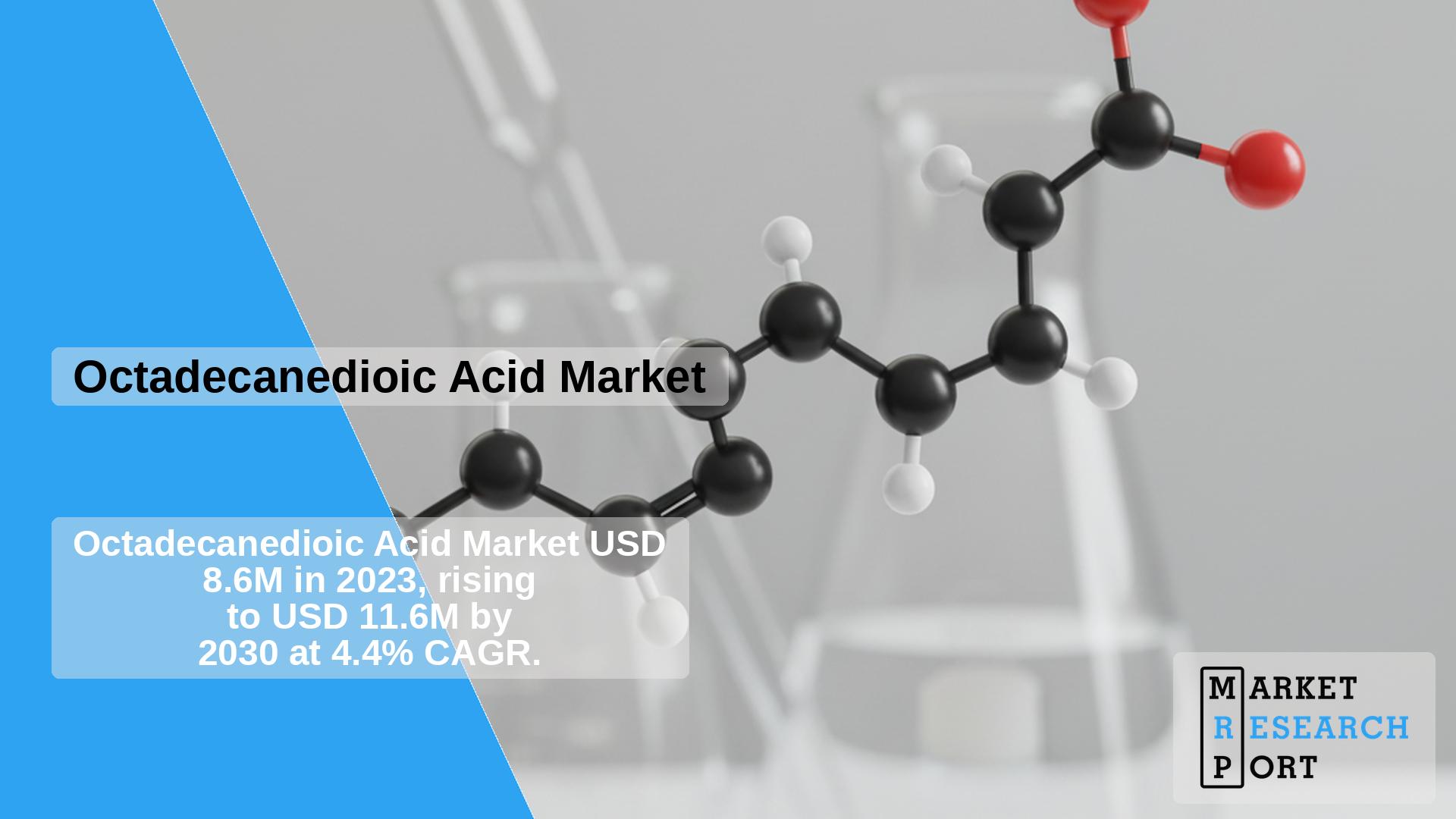
The global octadecanedioic acid (ODDA) market was valued at approximately USD 8.6 million in 2023 and is forecasted to reach USD 11.6 million by 2030, growing at a compound annual growth rate (CAGR) of 4.4% from 2024 to 2030. Factors contributing to this growth include rising demand for biodegradable polymers, expanding applications in sectors such as automotive and textiles, innovations in raw material processing, and supportive government policies encouraging sustainable and eco-friendly materials.
Increasing demand for robust and versatile polyester materials in industries like automotive, construction, and consumer goods is a major growth driver for ODDA. Additionally, its expanding use in healthcare applications such as drug delivery systems and biocompatible materials contributes to market growth.
Environmental regulations and sustainability considerations are also pushing manufacturers toward eco-friendly alternatives like ODDA. Advances in material science have led to new applications in advanced polymers and coatings, including biotechnological production methods utilizing renewable resources, aligning with global sustainability objectives.
Infrastructure projects in developing economies contribute to growing demand for durable materials enhanced by ODDA, particularly in construction coatings and composites. Furthermore, industries such as automotive, textiles, and electronics are increasingly adopting sustainable materials facilitated by government policies and rising environmental consciousness.
The polyester polyols application segment dominated the market in 2023 with a 50.2% revenue share. ODDA’s outstanding flexibility, elongation, and chemical resistance make it ideal for products requiring strength and durability. It is particularly utilized in automotive and construction industries for producing high-performance coatings with excellent adhesion and weather resistance.
The cosmetics segment is projected to exhibit the fastest CAGR of 5.1% during the forecast period, boosted by rising demand for anti-aging skincare products. ODDA improves skin elasticity and hydration, making it a valued ingredient in cosmetic formulations focused on product safety and efficacy.
North America held the largest market share of 30.9% in 2023, supported by a developed industrial base and numerous chemical manufacturers enhancing R&D for improved production processes and product quality.
The U.S. dominated North America’s ODDA market with a 78.0% share in 2023. It benefits from an advanced chemical manufacturing industry, skilled workforce, and complex supply chains. Government initiatives encouraging bio-based chemicals further promote ODDA adoption to enhance environmental sustainability.
The Asia Pacific region is forecasted to grow at the fastest rate of 5.6%, driven by industrialization, urbanization, and expansive investments in automotive, construction, and electronics sectors, particularly in China, India, and Japan. The cosmetics industry in this region is also growing due to rising incomes and demand for quality skincare products.
India has established itself as a key ODDA producer with significant investments in advanced chemical manufacturing facilities, enabling it to supply both domestic and international markets effectively.
Europe accounted for a significant market share in 2023, supported by robust industrial infrastructure and strict environmental regulations. Policies such as EPA limits encourage the use of ODDA in sustainable products like powder coatings and bio-based lubricants. The cosmetics sector values ODDA as a natural, skin-friendly ingredient, reflecting the region’s preference for organic and eco-friendly products.
Germany is a major contributor within Europe due to its large, technologically advanced chemical industry focused on research and development of specialty chemicals including ODDA.
Leading market players include Larodan AB, Procter & Gamble, Cathay Biotech Inc., Tokyo Chemical Industry (India) Pvt. Ltd., INDOFINE Chemical Company, Inc., XIAMEN SINOPEG BIOTECH CO., LTD., and Hunan Huateng Pharmaceutical Co., Ltd. These companies pursue strategies like product innovation, distribution expansion, and geographic growth to maintain competitiveness.
| Attribute | Details |
| Market size value in 2024 | USD 9.0 million |
| Projected revenue in 2030 | USD 11.6 million |
| CAGR | 4.4% (2024-2030) |
| Base year | 2023 |
| Historical data | 2018 – 2022 |
| Forecast period | 2024 – 2030 |
| Units measured | Volume (kilograms), revenue (USD million), CAGR (2024-2030) |
| Report coverage | Volume and revenue forecasts, company ranking, competitive landscape, growth factors, trends |
| Segments | Application, region |
| Regions covered | North America, Europe, Asia Pacific, Latin America, Middle East & Africa |
| Countries included | U.S., Germany, France, Japan |
| Key companies | Larodan AB, Procter & Gamble, Cathay Biotech Inc., Tokyo Chemical Industry (India) Pvt. Ltd., INDOFINE Chemical Company, Inc., XIAMEN SINOPEG BIOTECH CO., LTD., Hunan Huateng Pharmaceutical Co., Ltd |
This report presents revenue growth projections and trend analyses at global, regional, and country levels for 2018 to 2030, segmented by application and region.
The global octadecanedioic acid market was valued at approximately USD 8.6 million in 2023.
The market is projected to grow at a CAGR of 4.4% from 2024 to 2030, reaching around USD 11.6 million by 2030.
North America was the largest regional market in 2023, holding about 30.9% of the global share.
Asia Pacific is forecasted to experience the fastest growth throughout the forecast period due to rapid industrial and infrastructure development.
Polyester polyols accounted for the largest revenue portion in 2023, attributed to their extensive use in durable and flexible polymer applications.